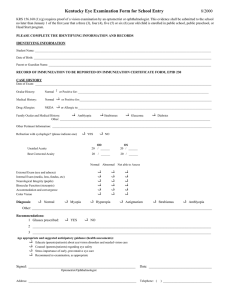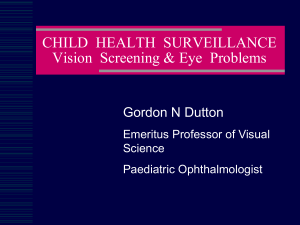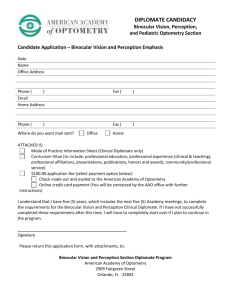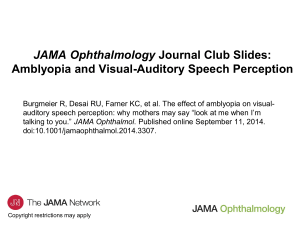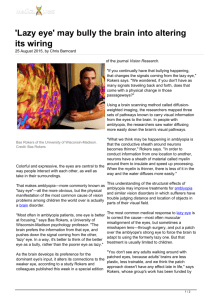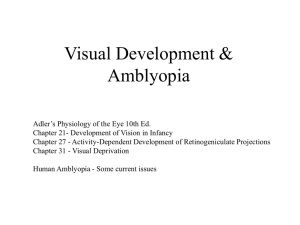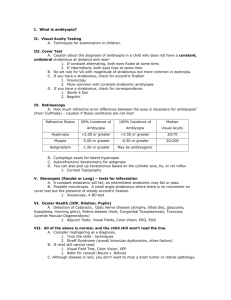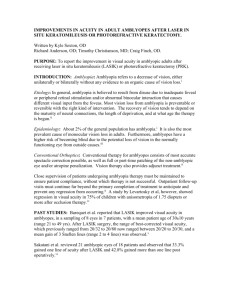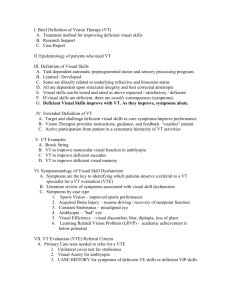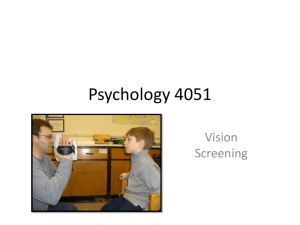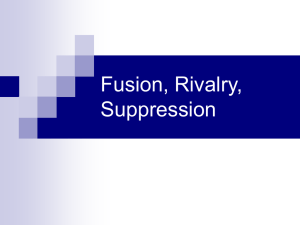Amblyopia - The Private Eye Clinic
advertisement
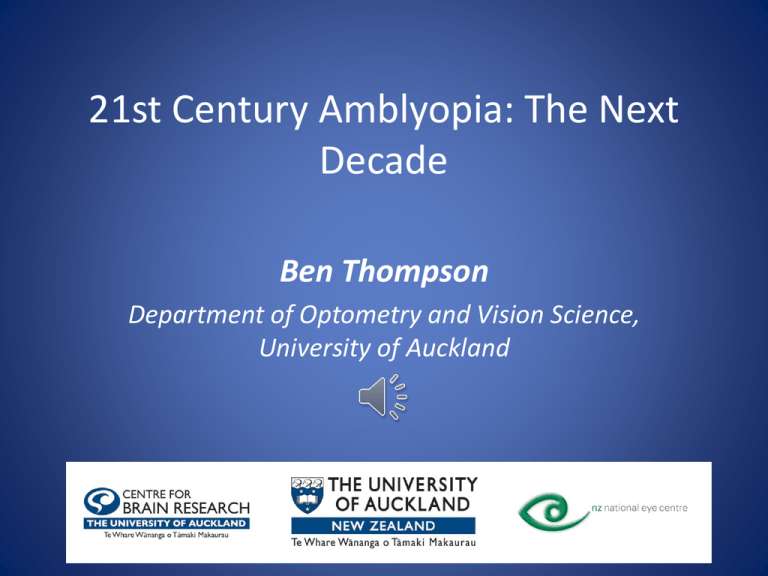
21st Century Amblyopia: The Next Decade Ben Thompson Department of Optometry and Vision Science, University of Auckland Overview • An example case • A description of the new treatment apparatus and technique • The scientific basis of the technique An Example Case • 23 year old female • Mixed unilateral amblyopia (combined anisometropia and strabismus) – Right Eye +0.25/-0.5x180 – Left Eye +2.25/-1.50x110 • 3° Esotropia • Amblyopia detected at age 2 • Surgery at age 7 • Treated with patching during childhood Visual Acuity Visual Acuity (LogMAR) 0.4 Amblyopic Eye Fellow Eye 0.3 0.2 0.1 0 -0.1 -0.2 Baseline Week 1 Week 2 Week 3 Stereo Sensitivity Stereo Sensitivity 0.003 0.0025 0.002 0.0015 0.001 0.0005 0 Baseline Week 1 Week 2 Week 3 The Treatment Device Background • Hypothesis: Adults with amblyopia have functional but suppressed binocular mechanisms – Antagonising GABA A receptors can restore binocular responses to neurons within the primary visual cortex of cats made experimentally amblyopic (Mower et al., 1984, Brain Research, 309, 168-172; Sengpiel et al., 2006, Cerebral Cortex, 16, 750-758) – Binocular summation can occur in adults with strabismic amblyopia if differences in monocular contrast sensitivity are accounted for (Baker et al., 2008, Vision Research, 48, 1625-1640) Overcoming Suppression • Can the manipulation of contrast differences between the eyes allow for binocular combination in amblyopia? Fellow eye Presented Perceived Amblyopic eye Objective Measurement of Suppression Signal Noise + = Mansouri et al. (2008), Vision Research, 48, 2775-2784 Can We Overcome the Suppression? Mansouri, et al. (2008), Vision Research, 48, 2775-2784 Measuring Suppression in Clinical Settings Black et al., (2011), Optometry and Vision Science, 88, 334-343. Reduction of Suppression Hess et al.,(2010). Restorative Neurology and Neuroscience, 28, 793-802 Principle Applied to a Portable Device To et al., (2011), IEEE Transactions on Neural Systems and Rehabilitation Engineering, 19, 280-289. Amblyopic Eye Acuity (Log MAR) 1 0.8 0.6 0.4 0.2 0 AnS JL Post Training MG MW CH Pre Training AS AF LB OH VT Summary • Binocular function may be present but suppressed in amblyopia • Reducing inhibitory interactions within the amblyopic visual system may improve both monocular and binocular visual function This might be how JIMMY SMITS has his amblyopia treated in 2015 • 4 yo • Presents with intermittent esotropia • Lea acuity R 6/9 [near 6/9] , L 6/36 [near 6/48] • L esotropia 25Δ [distance], 30Δ [near] • Cyclo R +2.5 DS, L +3.5 DS • Rx: glasses [full cyclo]. • Review monthly JIMMY SMITS 2 • 1 mo later: R 6/7.5, L 6/24. Straight for D&N. Suppression scotoma 5° diameter. Bagolini filter bar 8. • 2 mo later: R 6/7.5, L 6/21. Straight for D&N • 3 mo later: R 6/7.5+, L 6/21. Suppression scotoma 5° diameter. Bagolini filter bar 8. • Meets criteria for using McGill Tetris ® Gadget ™ – straight eyed anisometropic amblyope – failed progression of refractive amblyopia treatment . • Attends calibration session to reduce R contrast input to match the L amblyopia • Prescribed 30 minutes daily JIMMY SMITS 3 Glasses wear [weeks] R acuity 6/ L acuity 6/ *Size suppress ion scotoma ° **Depth Other suppress ion scotoma BFB 0 9 36 >5 >10 glasses 4 7.5 24 5 8 glasses 8 7.5 21 5 8 12 7.5+ 21 >5 7 16 7.5- 18 4 5 20 7.5+ 12 2.5 4 24 7.5- 9 1.5 4 * Using polarized 4 dot test P4D + McGill Tetris Gadget ** using Bagolini Filter Bar BFB Collaborators • Robert Hess, Dept. Ophthalmology, McGill University • Behzad Mansouri, Dept. Internal Medicine, University of Winnipeg • Jeremy Cooperstock, Dept. Computer Engineering, McGill University • Joanna Black, Dept Optometry and Vision Science, University of Auckland Health Research Council of New Zealand
